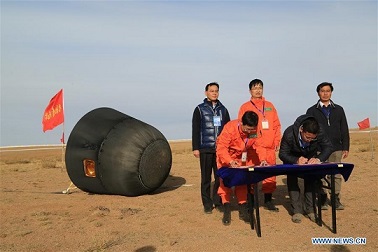
Scientific personnels sign for handover of capusle at the landing area of the re-entry capsule of China's first retrievable microgravity satellite SJ-10 in Siziwang Banner, north China's Inner Mongolia Autonomous Region, April 18, 2016. A Xinhua photo/CAS
BEIJING (BNS): The re-entry capsule of a scientific research satellite sent to space by China earlier this month has returned to Earth.
The bullet-shaped capsule from SJ-10, China's first retrievable microgravity satellite, landed at around 4:30 pm on Monday at the planned landing area in Siziwang Banner in north China's Inner Mongolia Autonomous Region.
The capsule was transferred to the China Academy of Space Technology (CAST), which will hand over the equipment aboard the capsule to the Chinese Academy of Sciences (CAS) for further analysis and assessment, the official Xinhua news agency reported.
The capsule separated from the orbital module of the probe about 15 minutes before its landing. The latter will remain in orbit before burning away, it said.
The SJ-10 satellite was launched by the indigenous Long March 2-D rocket from the Jiuquan Satellite Launch Center in northwestern China's Gobi desert on April 6. During its 12-day journey in space, 19 experiments on microgravity and life sciences were carried out on board.
One of the experiments was to study early-stage development of mouse embryos in microgravity to shed light on human reproduction in space.
For that, the probe carried over 6,000 mouse embryos in a self-sufficient chamber the size of a microwave oven.
According to the pictures sent back from a high-resolution camera, the 600 embryos, which were put under the camera, developed from the 2-cell stage, an early-on embryonic cleavage stage, to blastocyst, the stage where noticeable cell differentiation occurs, around 72 hours after SJ-10's launch.
The timing was largely in line with embryonic development on Earth, according to the CAS.
This is the first reported successful development in mammalian embryos in space in the history of science, the news report said.
The 15 pieces of equipment which carried 11 experiments loaded on the capsule were in good condition after experiencing the harsh space environment and the return trip.
The probe, which focuses on energy, agriculture, health, will give a boost to the basic research on bio-engineering, new materials and life sciences, in addition to pushing forward the development of China's research on microgravity and space life sciences.
 Previous Article
Previous Article Next Article
Next Article












The Indian Air Force, in its flight trials evaluation report submitted before the Defence Ministry l..
view articleAn insight into the Medium Multi-Role Combat Aircraft competition...
view articleSky enthusiasts can now spot the International Space Station (ISS) commanded by Indian-American astr..
view article